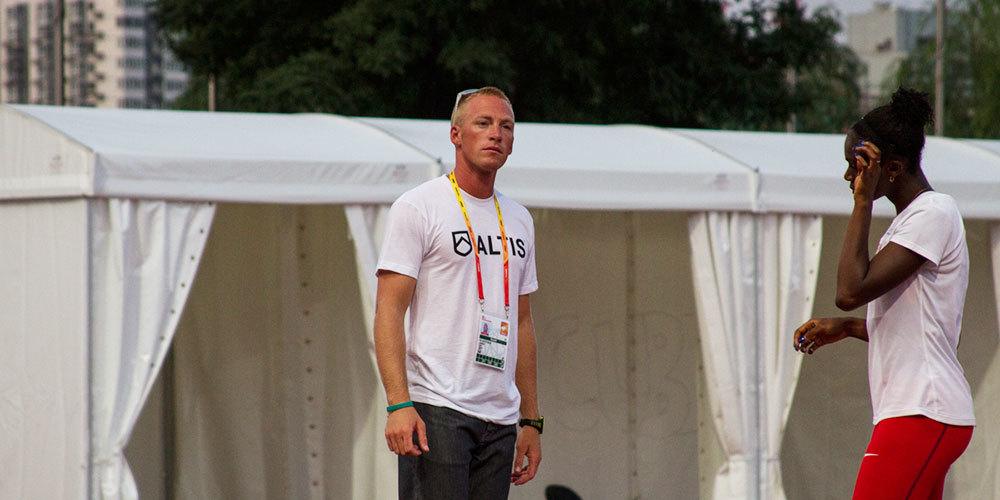This week’s blog-post, written by ALTIS sprints & jumps coach Dustin Imdieke, explores the true value of a mindfully designed and executed warm up.
“Practice?!? We talking about practice.” Allen Iverson famously made this statement 22 times to a group of reporters following the Philadelphia 76’ers elimination from the 2002 NBA playoffs. As the MVP of the league, Iverson made it clear that he felt practicing was not important – as long as his performance during games was on point. All too often I’ve witnessed a similar attitude displayed by Track & Field coaches and athletes regarding the warm-up; as if this component of the session is less important than the actual workout. At ALTIS the warm-up is a key component of each session in which coaches, therapists and athletes gain valuable information regarding athlete health, energy, focus, and skill levels for that given workout.
THE LIVING MOVEMENT SCREEN
During the last decade, static movement screens have been popularized as a method for coaches and therapists alike to assess athlete health, movement quality, and readiness to train. Coach Dan Pfaff explains that “coaches have been performing movement screens for decades; it’s called watching practice intently.” Each day our coaches and therapists watch closely as the athletes warm up, monitoring posture and the movement of key anatomical landmarks including the foot and ankle, knees, hips, thoracolumbar junction, and head. Through all of this we glean valuable information regarding the athlete’s current state. The warm-up also serves as a kinesthetic screen to help the athletes understand how their bodies are feeling and operating on that day. When deemed necessary by collaboration between the athlete, coach and therapist, the athlete will receive some form of manual therapy from one of the ALTIS therapists before proceeding on to the remainder of the session. These short and precise are analogous to the work that a pit crew would perform on an Formula 1 race car. Through short bursts of manual therapy we aim to affect key joints and tissues in an effort to optimize mechanical efficiency. This is all done in the name of improving performance and decreasing injury risk.
MOTOR EDUCATION
The introduction and teaching of proper biomechanics during the warm up serves as a key motor re-education opportunity. While sprinting, the actions of the feet, knees, hips, and shoulders are paramount to the level of success the athlete can achieve; these actions – as well as sprint related concepts, including vertical force production, ground vs. flight dynamics, and amortization can be discussed and explored during the warm-up.
While it is true that drills may not directly develop the ability to sprint, context and understanding about the desired postures and actions can be provided through appropriately designed warm up activities. Performed correctly over weeks and months, an effective warm-up can play a significant and positive role in shaping motor patterns.
INJURY REHABILITATION
Inevitably over the course of a season or career, every athlete suffers an injury of some sort. A proper movement based rehabilitation period is essential to returning the athlete to a state of readiness to train and compete. A well designed warm-up can serve as a major player in the rehab program. By imparting force and velocity through the tissue at specific ranges of motion, healing is promoted a rate far greater when compared to simply resting. With this in mind in the event of injury in ALTIS athletes, 24 hours post injury our athletes are not resting: Instead they perform a walking variation of the warm-up, and a plan B workout. This method of training and rehabilitation is instrumental in the reduction of training gaps that occur when an athlete is not able to implement a planned training session.
WARM UP CONTENT
Included below are the warm-up exercises used at ALTIS – there is nothing new here and they are very likely included within your program. I wish to make it clear that success does not depend on flash and gimmick; rather it depends on flawless execution of the basics. The famous scientist and inventor, George Washington Carver, implored us to “Learn to do the common things uncommonly well.”
Sprint Drills
A Skip
B Skip
Backwards Skip
Backwards Walk
Lateral Shuffle
Crossovers
Carioca
Butt Kicks
Dribble – Ankle
Dribble – Calf
Dribble – Knee
Straight Leg Scissor Bounds
Flexed Knee Scissor Bounds
High Knee Run
Fast Leg A
Fast Leg B
Dynamic Flexibility
Leg Swings – Frontal
Leg Swings – Sagittal
Trail Leg Windmill
Mountain Climbers
Donkey Kicks
Leg Whips
Hurdle Seat Exchange
Inverted Bicycle
Eagles – Prone
Eagles – Supine
Hip Circles
Side Bend
STARTING WITH THE END IN MIND
When a builder constructs a house the foundation is laid before the walls are erected. The roof is attached, and only then is the carpet put down. Without a strong foundation, cracks will form and the house will eventually crumble. Similarly, a well-performed warm-up serves as the foundation to a quality training session. It is our belief that the execution of the warm-up therefore deserves as much attention and mindfulness from the athlete, coach, and therapist as any other session component.

